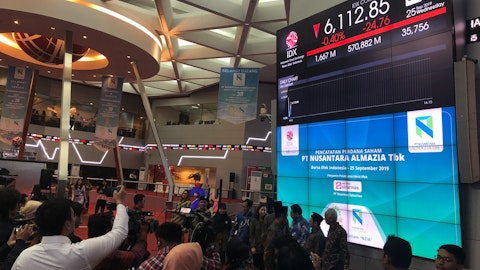Sea Limited (NYSE:SE) Q3 2023 Earnings Call Transcript November 14, 2023
Sea Limited misses on earnings expectations. Reported EPS is $-0.26 EPS, expectations were $0.55.
Operator: Good morning and good evening to all and welcome to the Sea Limited Third Quarter 2023 Results Conference Call. [Operator Instructions]. Please note, this event is being recorded. I’d now like to welcome Miss. Minju Song to begin the conference call. Please go ahead.
Minju Song: Thank you. Hello everyone, and welcome to Sea’s 2023 third quarter earnings conference call. I am Minju Song, from Sea’s Group Chief Corporate Officer’s Office. Before we continue, I would like to remind you that we may make forward-looking statements, which are inherently subject to risks and uncertainties and may not be realized in the future for various reasons as stated in our press release. Also, this call includes the discussion of certain non-GAAP financial measures such as adjusted EBITDA. We believe these measures can enhance our investors’ understanding of the actual cash flows of our major businesses when used as a complement to our GAAP disclosures. For a discussion of the use of non-GAAP financial measures and reconciliation with the closest GAAP measures, please refer to the section on non-GAAP Financial Measures in our press release.
I have with me Sea’s Chairman and Group Chief Executive Officer, Forrest Li, Group President, Chris Feng, Group Chief Financial Officer, Tony Hou, and Group Chief Corporate Officer, Yanjun Wang. Our management will share strategy and business updates, operating highlights, and financial performance for the third quarter of 2023. This will be followed by a Q&A session in which we welcome any questions you have. With that, let me turn the call over to Forrest.
Forrest Li: Hello everyone and thank you for joining today’s call. At our last earnings call, we shared that we would accelerate investment in e-commerce. In the past, our e-commerce business has made some significant shifts in operational focus to adapt to major business environment changes. Before diving into the details of the third quarter results, I would like to first share how the thinking behind each shift has been underpinned by our long-term view of the business. Our strategy for e-commerce is driven by the principle that maximizing the long-term profitability of the business will generate the greatest returns to our shareholders in the long run. And, maximizing long-term profitability requires scale and strong market leadership.
To achieve this long-term objective, we look at three key operational factors: growth, current profitability, and market share gain. While all are important and positively correlated in the long-run, near-term focus on one can create trade-offs for another. As business conditions change, sometimes rapidly, we need to decide which factor to prioritize for that period. During the pandemic, we focused on growth first, ramping up rapidly to meet surging demand for e-commerce despite the great operational difficulties created by lockdowns. This allowed us to achieve significant scale and strong market leadership when growth was very efficient. Subsequently, capital became very expensive and less available. So we made a rapid turn to achieve immediate profitability for Shopee as a first priority, while sustaining the platform’s scale and market leadership.
In both cases, we believe we made the right decisions in response to the shifting business environment. As we focus on long-term profitability and adapt to changes in the business environment, some short-term fluctuations in our results is inevitable. However, our demonstrated ability to adapt quickly and execute major transitions effectively is a core strength for the long-term success of our business. We are now deploying this strength to realize the next shift in our operational focus in e-commerce. In this period, we will prioritize investing in the business to increase our market share and further strengthen our market leadership. We made this decision in view of three recent developments. First, our move to self-sufficiency and profitability has significantly improved both our cash reserves and operational efficiency.
Our group cash position has increased by around $600 million from a year ago to more than $7.9 billion at the end of the third quarter. This puts us in a strong position to pursue more competitive and growth-focused strategies, while maintaining financial discipline and a strong balance sheet over the long run. Second, the entrance of new players has intensified competition in our markets. Competition may accelerate market share consolidation, and when markets stabilize, each remaining player will have sustainable profitability. Investing in market share gain now will position us better with even stronger market leadership when that happens. We thrive in a competitive environment. We competed aggressively and effectively in our markets for years to emerge as the clear market leader from an underdog position.
We now have scale, a deep understanding of our markets, and strong localized execution across diverse geographies. This gives us a wide competitive moat, and we intend to grow it further. Third, live streaming has become increasingly popular among sellers, buyers, and creators in our markets. These tailwinds give us a very good opportunity to build our e-commerce content ecosystem efficiently. We believe live streaming e-commerce will become a sizable and profitable part of our platform and extend our long-term growth potential. I want to emphasize that in making investment decisions, we are committed to maintaining a strong cash position, not relying on external funding, and investing within our means at a time and pace of our choosing. At the same time, given that e-commerce penetration remains low in most of our markets, we as the market leader have a responsibility to help grow the whole e-commerce ecosystem.
Shopee will remain committed to doing so in a healthy and sustainable way and driving value creation for all stakeholders. I hope that this brief sharing on the thinking behind our decisions has been helpful. Being nimble and therefore able to do the right thing at the right time remains a core strength and competitive advantage for our business. With that, I will invite Yanjun to discuss each business segment in more detail.
Yanjun Wang: Thank you, Forrest. Let me now share more details on the recent performance of each business segment, beginning with e-commerce. Just now, Forrest discussed the long-term objectives of our investment in e-commerce. For the immediate period, we assessed the effectiveness of our investment by looking at how our market leadership, as well as the scale and strength of our e-commerce content has been trending. On both fronts, we made strong progress in the past quarter. In the third quarter, growth in Shopee’s users, growth orders, and GMV accelerated sequentially. We saw average monthly active buyers growing 11% quarter-on-quarter with increased order frequency and improved buyer retention. As a result, our growth orders and GMV achieved 24% and 11% sequential growth respectively, further increasing our market share.
We also saw a material improvement in MTS scores broadly across the markets quarter-on-quarter and year-on-year. We believe this to be a good early indication of the effectiveness of our investment. Another key driver of our solid growth during the third quarter was the ramp-up of Shopee Live. During this period, we have made a strong push into e-commerce live streaming and increased collaborations with a growing ecosystem of content creators and live streaming sellers. We have also successfully acquired many new buyers and deepened our engagement with existing buyers. For example, in Indonesia, one out of five daily active users watched live streaming in October on average. With our efforts to help our sellers and creators, we saw a significant increase in their participation in Shopee Live.
Our number of average daily unique streamers, total daily hour streams, and the number of daily stream sessions for October all grew by more than three times compared to June. Our streamers are also becoming more engaged, with the average stream duration per streamer increasing by more than a third during the same period. In Southeast Asia, our average daily orders on live streaming already reached more than 10% of the total order volume for October. For our investments in live streaming, we have a targeted focus on key categories such as fashion and health and beauty. These categories tend to benefit more from this format of user engagement and tend to enjoy higher margins. This further strengthens our overall market leadership in these key marketplace categories.

Moreover, we have been focused on investment efficiency and driven fast improvement in unit economics. This is well in line with our long-term view that live streaming e-commerce can be both a meaningful part of our platform and our business. As shared before, we are consistently focused on reducing cost to serve for our e-commerce ecosystem. We made strong progress in continuing to drive down logistics costs while improving user experience. Our platform logistics costs per order for our Asia market decreased by 17% year-on-year in the third quarter. Decreases in logistics costs also contributed to the year-on-year decline in our value-added services revenue. We believe this to be an example of scale economic share where we drive down logistics costs with scale and pass the benefits of reduced shipping costs to our sellers and buyers.
This business model also serves to strengthen the competitive mode of our platform. As we scale the Shopee platform, we also continue to expand the coverage of our logistics network across our market to reach more sellers and buyers. This will be done through better routing for more efficient and faster delivery, further expanding our network of sorting centers, and improving our large-scale coverage. In the third quarter, Brazil continues to enjoy strong growth. At the same time, our user economics in Brazil improves. We will continue to invest in category expansion and user acquisition in this market. And we will take a balanced approach of investing in growth while driving improvements in operational efficiency, especially in logistics. Our results in Brazil for the quarter speak to our success on both fronts.
While we believe we already achieved sufficient scale and cost efficiency to be profitable in Brazil, our focus remains on capturing the growth opportunity there. Looking into the fourth quarter, we will continue to invest in the holiday shopping season, which we believe is a good time to acquire users, gain market share, and strengthen our content ecosystem. Moving on to digital entertainment. In the third quarter, Garena’s bookings grew sequentially, while quarterly active users and adjusted EBITDA remained stable quarter-on-quarter. We view these results positively as this was achieved despite schools reopening across a number of our key markets during the quarter. We are happy to see that Free Fire maintains stable trends across both user and monetization metrics.
Many of our initiatives around improving the user experience this year, such as reducing loading times, have shown continued success. We have also further deepened user engagement. For example, we recently revamped Free Fire’s guild system to enhance the social experience for our players. With all these efforts, we saw a higher revival of churned users and better user retention. Indeed, Free Fire was the most downloaded mobile game in the third quarter globally, according to Sensor Tower. We are also pleased to see healthy trends for our portfolio of published games. We added fresh, exciting content and enhanced the user experience for these games. New content on Arena of Valor received very positive user feedback, resulting in a new peak of quarterly active users for the game.
Another of our published games, Call of Duty Mobile, achieved its highest quarterly bookings. This was a result of both our continued efforts to improve the game experience for players through better optimization and successful content collaboration. We will continue to assess new development and publishing opportunities for Garena. Lastly, on our digital financial services business. In the third quarter, SeaMoney delivered strong revenue and profit growth, mainly driven by our credit business, which grew steadily quarter-on-quarter. As of the end of the third quarter, we had a total credit portfolio of $2.9 billion, growing 5% sequentially. The portfolio included $2.4 billion of gross loans receivable on our balance sheet. The remaining approximately $0.5 billion of principal amount of loans outstanding were from channelling arrangements, which is lending by other financial institutions on our platform.
In terms of credit product type, $1.4 billion in the total credit portfolio were SPayLater consumption loans, which are used to pay for transactions on or off the Shopee platform. The remaining balance mostly consisted of cash loans to Shopee buyers and sellers. The quality of our loan book stayed healthy. Loans past due by more than 30 days and 90 days as a percentage of the gross loans receivable on our balance sheet was 5.2% and 1.6% respectively, improving quarter-on-quarter. We also continued to extend the funding sources. In fact, the majority of the gross loans receivable on our balance sheet were funded by sources such as deposits in our banks and asset-backed lending from third-party financial institutions. We will continue to further diversify our credit portfolio across markets and products, both on and off Shopee platforms, and optimize our sources funding to improve costs and diversify risk.
Our digital bank offerings have made good progress during the quarter. For example, our banks in Indonesia, the Philippines, and Singapore have seen strong user adoption of the direct debit services, where buyers can make payments on Shopee directly from their accounts with our banks. The service has driven an acceleration in user acquisition for our banks and improved transactional experience on Shopee. This is also another example of our strong ecosystem synergy. To sum up, SeaMoney has become an increasingly important pillar of our core businesses. It is contributing meaningfully towards both our top line and bottom line. It has enjoyed a healthy and improving risk profile and strong ecosystem synergy. Under SeaMoney, we will continue to strive to develop more comprehensive products and services to meet the financial needs of our users across the market.
With that, I will invite Tony to discuss our financials.
Tony Hou: Thank you, Yanjun, and thanks to everyone for joining the call. We have included detailed financial schedules together with a responding management analysis in today’s press release, so I will focus my comments on the key metrics. For Sea overall, total GAAP revenue increased 5% year-on-year to $3.3 billion. This was primarily driven by the improved monetization in our e-commerce and the digital financial services businesses. Our group total adjusted EBITDA was $35 million compared to an adjusted EBITDA loss of $358 million in the third quarter of 2022. On e-commerce, our third quarter GAAP revenue of $2.2 billion included GAAP marketplace revenue of $1.9 million, up 18% year-on-year, and GAAP product revenue of $0.3 billion.
Within GAAP marketplace revenue, core marketplace revenue, mainly consisting of transaction-based fees and advertising revenue, was $1.3 billion, up 32% year-on-year, as a result of both increases in advertisement uptakes by sellers on our platforms and commission rates. Value-added services revenue, mainly consisting of revenues related to logistic services, was $0.6 billion, down 4% year-on-year. E-commerce adjusted EBITDA loss was $346 million in the third quarter of 2023, compared to an adjusted EBITDA loss of $496 million in the third quarter of 2022. For our Asia market, we had an adjusted EBITDA loss of $306 million during the quarter, compared to an adjusted EBITDA loss of $217 million in the third quarter of 2022. In our other markets, the adjusted EBITDA loss was $40 million, narrowing meaningfully from last year, when losses were $279 million.
Contribution margin loss per order in Brazil improved by 91% year-on-year, to reach $0.10 reflecting better monetization and higher efficiency in our ecosystem. Digital entertainment bookings were $448 million, and GAAP revenue was $592 million. Adjusted EBITDA was $234 million, compared to $239 million in the second quarter of 2023. Digital financials services GAAP revenue was up by 37% year-on-year, to $446 million. Adjusted EBITDA was $166 million in the third quarter of 2023, compared to an adjusted EBITDA loss of $68 million in the third quarter of 2022. We recognized a net non-operating income of $46 million in the third quarter of 2023, compared to a net non-operating loss of $9 million in 2022. The year-on-year improvement was mainly due to higher interest income in the third quarter of 2023.
We had a net income tax expense of $62 million in the third quarter of 2023, compared to a net income tax expense of $65 million in the third quarter of 2022. As a result, net loss was $144 million in the third quarter of 2023, as compared to net loss of $569 million in the third quarter of 2022. With that, let me turn the call to Minju.
Minju Song: Thank you, Forest, Yanjun and Tony. We are now ready to open the call to questions.
See also 14 Best Depressed Stocks To Buy Now and 10 Weirdest, Unusual ETFs You Can Buy.
Q&A Session
Follow Spectra Energy Corp. (NYSE:SE)
Follow Spectra Energy Corp. (NYSE:SE)
Operator: [Operator Instructions] Our first question comes from Piyush Choudhary from HSBC. Your line is now open.
Piyush Choudhary: Hi, good evening, management team, and thanks for the opportunity. Three questions. Firstly, in e-commerce, can you discuss how long we may continue to be loss-making for Shopee, and what is the specific market share level or what other KPIs Shopee may be aiming to achieve before spending starts to normalize? In the digital entertainment segment, what led to quarter-on-quarter softness in pay users despite of new game launch, and any insights on the outlook for the pay user base? And lastly, in the DFS segment, can you talk about the outlook for the lending growth? Is there a scope for increasing lending user penetration, or will it grow in line with Shopee GDP?
Forrest Li: Thank you. I will take the e-commerce question first. Regarding the probability of e-commerce, as we have demonstrated in the past few quarters, we have the capability to turn distances to break even quickly anytime if we want to. However, as far as shares, to maximize our long-term profitability, we will keep our organization nimble and flexible and adjust our operations based on the dynamic in the market conditions. For example, we look at both the growth of the market, we look at the probability for the current quarter. We also look at market share dynamics in the market. In terms of investment plan, we look at both the general investment efficiency and also the specific growth opportunities in each of the markets.
For example, if we look at the general investment efficiency, we look at will we put some investment in the market, will we see the return if we want it, do we see market share gain, for example, with the better economic compared to our competitive market. For the specific opportunity in our market, one of the examples we mentioned earlier in the call was the content acquisition building, the live stream opportunity in particular, where we see a very good time for us to invest to grow this part of the business at this particular time. We target to invest within our means, just to emphasize on that again. We would like to maintain a strong cash position at all times and not rely on the external funding. It’s also important to note that if we look at our investment efficiency in the past few months, I think we have the positive numbers as we shared by Yanjun and Tony earlier, but if you look at month to month, we do see the efficiency [Ph] are improving month to month.
If we look at the trend, we see a clear trend for Shopee to break even while achieving our market share and content acquisition building goals. There are many KPIs to look at. Market share is one of the KPIs, of course, but there are many other things, for example, how is our growth of our user base, how is the growth of our time spent on our apps, our MAUs, EAUs, and also, of course, how much profitability that we achieve during the month. All these are important KPIs to look at rather than looking at market share only. Thank you.
Yanjun Wang: Regarding the question on game Q-on-Q subnet users, I think this is actually to us some early indication of seasonality we start to see in the game performance. When we start to see seasonality, it’s also a good indication of stability in the game performance. That’s why we do not see it as a negative sign. We also mentioned on the call that in Q3, we saw a lot of school reopening and there are also less holidays. So that does affect the user engagement. But overall, we are very happy to see the improvement in user retention and also in the re-engagement of changed users, as I mentioned earlier.
Tony Hou: On the last question on the credit for DFS. In general, we do see both possibilities of letting growth on the GMB of Shopee and the penetration of credit in Shopee. Of course, that depends on quarter-on-quarter, depends on the risk profile we want to achieve and the growth that we want to control. In general, we grow on both Shopee GMB and penetration. On top of that, I just want to emphasize that our credit is not only to Shopee ecosystem. We do have a good growth on the credit portfolio outside of Shopee ecosystem. For example, the Shopee Pay channel offline, we do see a good penetration for credit on the offline for Shopee Pay channel as well. We do also have other scenarios we are developing over time.
Piyush Choudhary: Thank you.
Operator: Our next question comes from Pang Vitt from Goldman Sachs. Your line is now open.
Pang Vittayaamnuaykoon: Hi, good evening management team and thank you very much for the opportunity. Three questions from me. Number one for e-commerce. Can you discuss where Shopee investment went into in third quarter and whether you achieved the outcome you wanted? What are your considerations on spending and GMB growth target for fourth quarter, especially considering some of the reasons of regulatory changes we see in Indonesia? That’s question number one. Question number two regarding Gaming. Can you discuss the latest development with regards to right of first refusal agreement with Tencent that supposedly expired this month? Can it automatically renew and how would that impact user pipeline? That’s two. And number three for the fintech segment.
Can you discuss about the credit quality of your loan book? We continue to see credit loss provisioning trending better every quarter. Will this be your new runway or how should we think of this margin of this business in the long-term?





